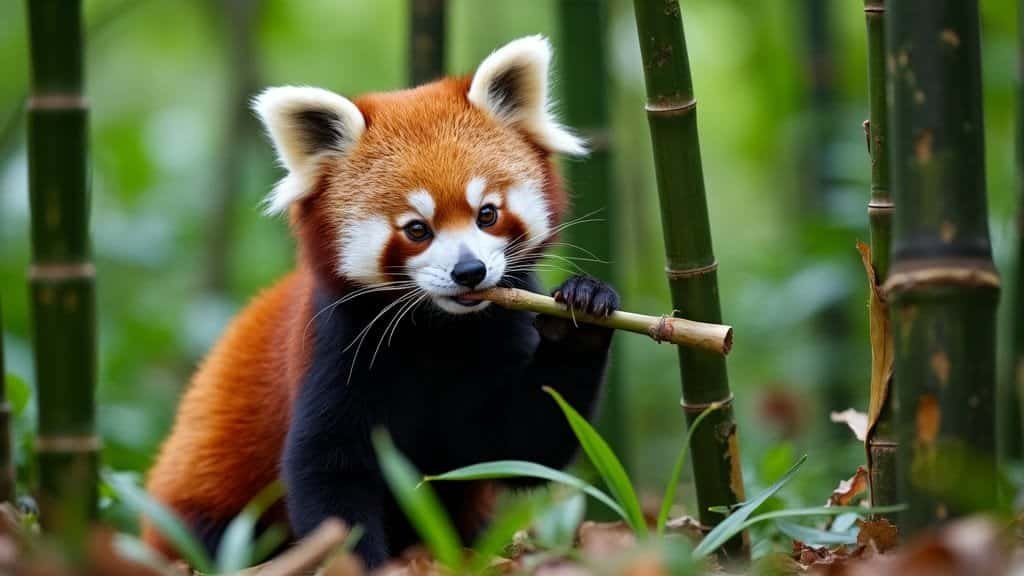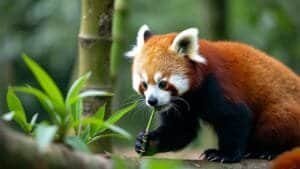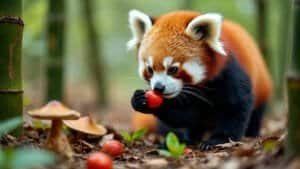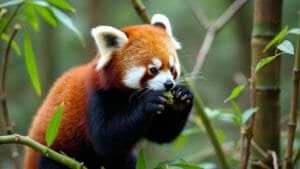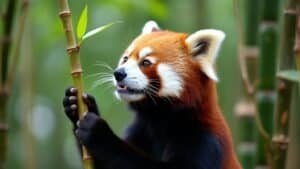Red pandas are classified as carnivores, yet their diet consists almost entirely of bamboo, a plant-based food that provides very little protein and energy. Despite lacking the digestive system of a true herbivore, red pandas consume large quantities of bamboo daily, eating 2.2 to 4.4 pounds (1 to 2 kg) per day and spending up to 13 hours feeding to compensate for their low nutrient absorption
The reason for this high intake lies in evolutionary adaptation. Although red pandas share ancestry with meat-eating carnivores, they have developed specialized traits—including strong molars, a pseudo-thumb, and a slow metabolism—that allow them to survive on bamboo. However, because bamboo is difficult to digest, red pandas must be highly selective in choosing the most nutrient-rich parts of the plant, such as tender shoots and young leaves
This article explores why red pandas eat so much bamboo, how their digestive system struggles to process plant material, and what biological adaptations help them survive on such a nutritionally poor diet. We will also compare their diet to giant pandas, examine their evolutionary history, and discuss the conservation challenges they face as habitat loss threatens their primary food source
The Red Panda’s Dependence on Bamboo
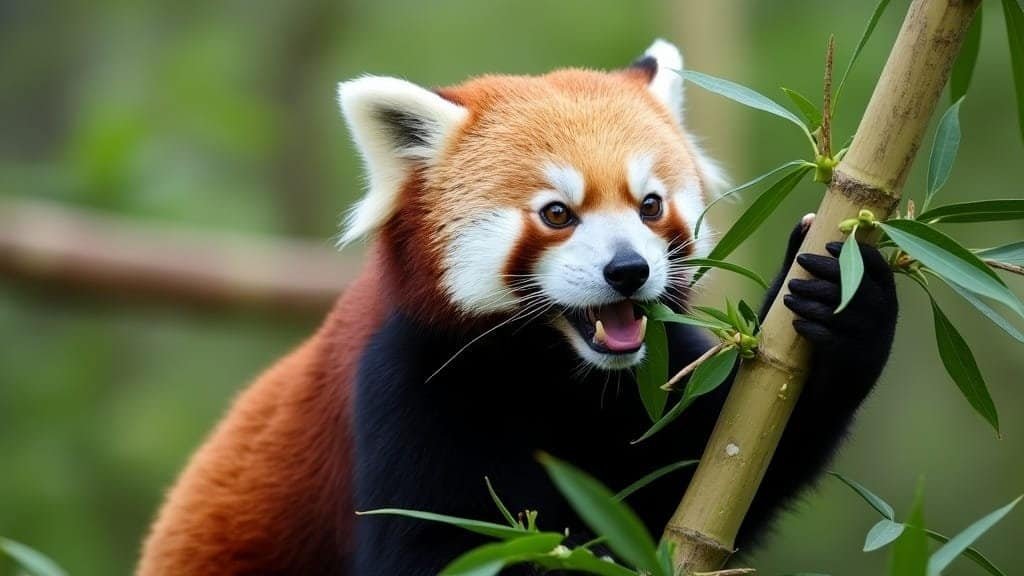
Red pandas are unique among carnivores because their diet consists almost entirely of bamboo. Despite lacking the specialized digestive system of a true herbivore, they have evolved to survive on this fibrous plant through behavioral and metabolic adaptations. Their reliance on bamboo has shaped their feeding habits, energy conservation strategies, and overall survival in their forest habitat
Why Do Red Pandas Rely Almost Entirely on Bamboo?
Bamboo is the primary food source for red pandas because it is abundant and available year-round in their native forests across the eastern Himalayas and southwestern China. Unlike fruits or insects, which are highly seasonal, bamboo provides a consistent food supply, eliminating the need for long migrations in search of food. However, despite its accessibility, bamboo is extremely low in digestible nutrients. This means that red pandas must eat large amounts daily to obtain the energy they need to survive
Although red pandas belong to the carnivorous lineage, they adapted to a plant-based diet due to ecological pressures and food competition with other species. Their transition to bamboo allowed them to occupy a unique feeding niche, reducing competition for resources. However, because bamboo contains little protein and is difficult to digest, red pandas extract only a small portion of its available energy
A study by Wei et al. (Journal of Mammalogy, 2014) found that red pandas absorb only about 24 percent of the nutrients in bamboo, making their diet highly inefficient. To compensate for this limitation, they exhibit selective feeding behavior, choosing the most nutrient-rich parts of the plant, such as tender shoots and young leaves, which contain more protein and water than mature leaves and stalks
Despite their dependency on bamboo, red pandas have not developed the complex digestive system seen in herbivores such as cows or deer. They lack the specialized gut bacteria and multi-chambered stomachs required to break down cellulose efficiently. As a result, much of what they consume passes through their digestive system without being fully processed, forcing them to spend a significant portion of their day eating to maintain their energy levels
How Much Bamboo Does a Red Panda Eat Daily?
Because of the low caloric value of bamboo, red pandas must consume between 2.2 and 4.4 pounds (1 to 2 kg) of bamboo daily to survive. This means they spend up to 13 hours per day feeding, carefully selecting the most digestible parts of the plant. Unlike animals that eat large meals at specific times of the day, red pandas engage in continuous feeding, alternating between eating and resting. This behavior allows them to process as much bamboo as possible while minimizing energy expenditure
Their diet changes slightly depending on the season. During the spring and summer months, red pandas primarily eat bamboo shoots, which are richer in protein, water, and digestible carbohydrates. These young shoots provide the most nutrients with the least effort, making them the preferred food source when available. As the seasons shift and shoots become less abundant, red pandas transition to younger bamboo leaves, which still offer some nutritional benefits but require more effort to chew and digest. By the time winter arrives, they are forced to rely on mature leaves and stalks, which contain more fiber and fewer nutrients, making digestion even more challenging
In captivity, red pandas are often provided with a more balanced diet, including fruits, leaf-eater biscuits, and small amounts of protein. These additional food sources help compensate for the nutritional deficiencies of bamboo. However, in the wild, red pandas have no alternative food sources during certain times of the year, reinforcing their dependence on bamboo as a staple food
How Does a Red Panda’s Digestive System Process Bamboo?
Despite their reliance on bamboo, red pandas have a short digestive tract that more closely resembles that of carnivorous mammals rather than herbivores. Unlike true plant-eaters, which have long intestines and specialized stomachs to break down cellulose, red pandas have a relatively simple gut that is poorly suited for digesting fibrous plant material. This biological limitation makes bamboo an inefficient food source, requiring red pandas to consume it in massive quantities to extract enough energy
To compensate for this inefficiency, red pandas exhibit highly selective feeding behaviors. They focus on the most digestible and nutrient-rich parts of bamboo, such as tender shoots and young leaves, while avoiding tougher, older stalks whenever possible. Their strong molars and jaw muscles help them crush bamboo fibers, breaking down the plant material before it enters their digestive system. However, even with these adaptations, their ability to extract nutrients from bamboo remains low compared to herbivorous mammals
Another critical survival strategy red pandas employ is energy conservation. Since their diet provides minimal calories, they reduce their activity levels and rest frequently between feeding sessions. During the winter months, when bamboo is less nutritious, they further slow their metabolism to conserve energy. A study by Squires et al. (Frontiers in Zoology, 2021) found that red pandas can slightly lower their body temperature in colder conditions, helping them survive on a low-energy diet without experiencing extreme weight loss
Their dependence on bamboo makes red pandas vulnerable to habitat loss and environmental changes. Since they rely on bamboo forests for food, any disruption to their ecosystem—whether due to deforestation, climate change, or human development—can severely impact their survival. Conservation efforts focus on preserving bamboo-rich habitats to ensure that red pandas continue to have access to their primary food source
For more insights on why red pandas rely so heavily on bamboo, visit the Bioparc Fuengirola’s article on red panda diets
Evolutionary and Biological Factors

Red pandas belong to the order Carnivora, yet they survive on a diet composed almost entirely of bamboo. This paradox can be explained by a combination of evolutionary history, digestive inefficiency, and physical adaptations that have allowed red pandas to gradually shift from an ancestral carnivorous diet to a plant-based one. Despite this transition, they still retain several biological characteristics that reflect their carnivorous origins
Why Are Red Pandas Classified as Carnivores Despite Eating Plants?
Red pandas are classified as carnivores because of their evolutionary lineage, not their dietary habits. They belong to the superfamily Musteloidea, which includes raccoons, weasels, and skunks—animals that primarily consume meat or an omnivorous diet. However, over millions of years, red pandas gradually adapted to an herbivorous diet, with bamboo becoming their primary food source
Their classification as carnivores is based on anatomical and genetic traits rather than their current eating habits. Unlike herbivores, red pandas have a short digestive tract, which is typical of meat-eating species. Additionally, they lack the specialized gut bacteria needed to break down cellulose efficiently, making bamboo a difficult food to digest. Although they have evolved flattened molars for grinding plant material, their teeth are still more similar to those of carnivorous relatives than to those of true herbivores such as deer or cows
Despite their adaptation to a bamboo diet, red pandas retain some carnivorous behaviors. They occasionally consume fruits, insects, and bird eggs, particularly when bamboo is scarce. However, these foods make up only a small fraction of their diet, reinforcing their dependence on bamboo as their primary food source
How Does Bamboo’s Low Nutritional Value Affect Red Pandas?
Bamboo is an extremely low-energy food, providing very little protein, fat, or digestible carbohydrates. While young bamboo shoots offer higher protein content, mature leaves and stems contain mostly fiber and indigestible cellulose, making them a poor source of energy. Unlike herbivorous mammals that have evolved complex digestive systems to extract nutrients from plants, red pandas lack the necessary adaptations to process bamboo efficiently
Because of this nutritional limitation, red pandas must consume bamboo in large quantities and spend most of their day feeding. A study by Wei et al. (Journal of Mammalogy, 2014) found that red pandas must eat continuously for up to 13 hours per day to extract enough nutrients from bamboo. This inefficient energy conversion forces them to be highly selective eaters, choosing only the most digestible parts of the plant
The challenges of a bamboo-based diet also impact red panda behavior. During winter, when bamboo is less nutritious, they reduce activity levels and conserve energy by resting for long periods. Their ability to survive on such a poor diet is largely due to their low metabolic rate, which helps them maintain body weight despite a low-calorie intake. However, this extreme dietary specialization also makes red pandas highly vulnerable to food shortages, as any disruption to their bamboo supply can threaten their survival
What Adaptations Help Red Pandas Consume and Digest Bamboo?
Despite their carnivorous ancestry, red pandas have evolved several physical adaptations that help them survive on a bamboo-heavy diet. One of their most distinctive features is their pseudo-thumb, an extended wrist bone that functions like an opposable thumb. This adaptation allows them to grasp and manipulate bamboo stalks, making feeding more efficient. This feature is also found in giant pandas, despite the two species not being closely related, demonstrating a case of convergent evolution in response to a bamboo diet
Their teeth and jaw structure have also adapted to bamboo consumption. Red pandas have broad, flat molars that are well-suited for crushing and grinding tough plant fibers. Their strong jaw muscles help them chew for extended periods, breaking down the fibrous material before digestion. Although their teeth are more adapted to herbivory than those of their carnivorous relatives, they are still not as specialized as those of true herbivores, further contributing to their digestive inefficiency
Another important adaptation is their slow metabolism, which allows them to survive on a diet that provides very little energy. Unlike carnivores, which have high metabolic rates to support active hunting and meat digestion, red pandas conserve energy by limiting movement and resting between feeding sessions. This energy conservation strategy is crucial, particularly during colder months when food quality declines
These adaptations highlight how red pandas have transitioned from a carnivorous ancestry to a bamboo-based diet, despite retaining many biological traits associated with meat-eaters. Their reliance on bamboo, combined with their inefficient digestion, has forced them to develop unique survival strategies, allowing them to thrive in environments where few other species can
For more insights into red panda adaptations and their dietary evolution, visit the Safe Worldwide page on red pandas
Comparative Analysis of Red Panda Diets

Red pandas share their bamboo-based diet with giant pandas, but despite this similarity, their feeding habits, metabolic strategies, and nutritional needs differ significantly. Unlike giant pandas, which have adapted almost entirely to bamboo, red pandas still consume small amounts of fruits, insects, and eggs when available. Understanding these differences provides insight into how each species has adapted to its ecological niche
How Does a Red Panda’s Diet Compare to a Giant Panda’s?
Although both red pandas and giant pandas rely on bamboo, their dietary habits differ due to body size, metabolic needs, and digestive efficiency. A giant panda, which can weigh up to 300 pounds (136 kg), consumes 26 to 84 pounds (12 to 38 kg) of bamboo daily. In contrast, a red panda, which weighs between 6.5 and 14 pounds (3 to 6.2 kg), eats only 2.2 to 4.4 pounds (1 to 2 kg) per day. This difference in consumption is directly related to body size—giant pandas require much more energy to sustain their larger mass, while red pandas can survive on significantly less
Despite both species feeding on bamboo, giant pandas have evolved better digestive adaptations. Their gut microbiome contains more bacteria specialized for breaking down cellulose, allowing them to extract more energy from bamboo than red pandas can. Additionally, giant pandas have a longer digestive tract, which increases the time food stays in their system, maximizing nutrient absorption. Red pandas, in contrast, have a short digestive tract that passes food more quickly, resulting in lower nutrient absorption and requiring them to eat more frequently
Another key difference is in dietary flexibility. While red pandas consume fruits, berries, flowers, and small amounts of protein in addition to bamboo, giant pandas are almost entirely dependent on bamboo. This difference in dietary diversity reflects their evolutionary history—red pandas retain more carnivorous traits and supplement their diet with occasional animal-based foods, whereas giant pandas have become fully herbivorous over time
Do Red Pandas Eat Anything Besides Bamboo?
Although bamboo makes up 85-95% of a red panda’s diet, they do occasionally eat fruits, berries, flowers, insects, and small vertebrates when available. These foods help supplement their nutritional intake, providing essential sugars, vitamins, and proteins that bamboo lacks
Fruits, such as apples, wild figs, and raspberries, are an important seasonal food source, especially in summer and early fall, when they are more abundant. These fruits provide natural sugars that help red pandas build fat reserves before winter, when food is less nutritious. A study by Wei et al. (Journal of Mammalogy, 2014) found that red pandas consume more fruit in late summer, likely to prepare for colder months
Insects, such as caterpillars, grubs, and beetles, are another occasional protein source. While red pandas do not actively hunt, they opportunistically consume small invertebrates when they come across them. Similarly, bird eggs and small mammals may be eaten if found, but these foods make up only a tiny fraction of their diet
In captivity, red pandas are often fed fruits, leaf-eater biscuits, and mealworms to provide balanced nutrition. However, in the wild, their diet is limited by seasonal availability, reinforcing their dependence on bamboo as their primary food source
How Do Red Pandas Conserve Energy While Surviving on Bamboo?
Because bamboo is low in calories, red pandas must conserve energy to survive. Their slow metabolism helps them function on a diet that provides little energy compared to a carnivorous diet. Instead of being highly active hunters like other members of the Carnivora order, red pandas spend most of their day eating and resting
In colder months, red pandas further reduce their activity levels, spending more time sleeping and limiting unnecessary movement. This energy-saving strategy allows them to survive on low-quality bamboo leaves and stalks without experiencing significant weight loss. A study by Squires et al. (Frontiers in Zoology, 2021) found that red pandas can lower their metabolic rate and slightly reduce their body temperature in winter, a mechanism that prevents excessive energy loss
Their thick fur and compact body shape also play a role in conserving energy. By minimizing heat loss, red pandas require fewer calories to maintain body temperature, making it easier to survive on a low-energy diet. Unlike some large herbivores, which must migrate to find food, red pandas stay within their home range year-round, relying on bamboo forests for sustenance
For further insights into red panda feeding habits and energy conservation, visit the Animals Asia article on red pandas
